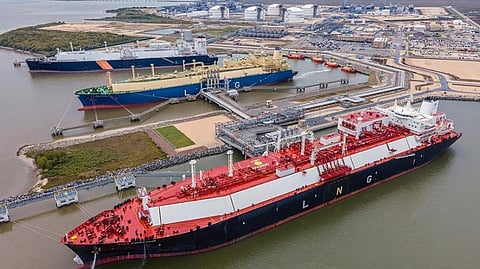

Europe will need to import up to 160 additional LNG cargoes this winter due to lower storage and a decline in pipeline flows from Russia and Algeria, according to analysts and data, deepening its dependency on US gas.
LNG imports will jump to 820 tankers this year from 660 last year, representing 48 per cent of all EU gas supply, with analysts forecasting need for around 16 billion cubic metres (bcm) this winter.
A decade ago, LNG covered only 10 per cent of EU gas needs, and the share stood at 23 per cent in 2021 before Russia invaded Ukraine and the bloc cut Russian pipeline imports.
The typical modern LNG cargo vessel has a capacity of around 0.1 bcm.
US LNG exports saved Europe from a deeper gas crisis in 2022, but that growing reliance has created unease as the Trump administration hit trading partners, including the EU, with tariffs this year.
The United States will supply around 70 per cent of Europe's LNG in 2026-2029, up from 58 per cent so far this year, as the EU plans to ban Russian LNG from 2027 and Russian gas from 2028, Energy Aspects analysts said.
US gas production and export capacity are surging, while growth from other suppliers will be limited, they said.
"Our dependency on the US will grow," said an executive at a major European utility, speaking on condition of anonymity, citing limited options to buy gas elsewhere.
Imports from Algeria have fallen. And Europe's top domestic supplier, Norway, also faces a gradual production decline.
Prices of long-term gas pipeline imports are generally less volatile than spot LNG prices.
That means Europe's gas outlook is increasingly shaped by external risks such as Chinese LNG demand that can trigger price swings and discourage stockpiling, said Arne Lohmann Rasmussen, head of research at investment firm Global Risk Management.
EU gas storage stood at 82.75 per cent, or 944 terawatt hours, of capacity as of October 4, down from 94.32 per cent last year and at their lowest levels since 2021, data from industry lobby group Gas Infrastructure Europe showed.
Storage levels had dropped below 34 per cent in March 2025, the lowest since 2022.
Lower pipeline supply and increased reliance on LNG will require much steeper storage withdrawals and injections in the future, said Florence Schmit, energy strategist at Rabobank.
By the end of the current winter in March 2026, storage volumes could drop to a seven-year low of 29 per cent of capacity, according to Kpler.
That would add a significant risk premium to EU gas prices in 2026, Energy Aspects said.
(Reporting by Nora Buli in Oslo and Alban Kacher in Gdansk ; Additional reporting Francesca Landini in Milan; Editing by Joe Bavier)
